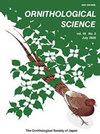Breeding Ecology of the Snow Partridge (Lerwa lerwa) in High-Altitude Regions, Tibet
IF 0.3
4区 生物学
Q4 ORNITHOLOGY
引用次数: 1
Abstract
Abstract To explore the environmental adaptation strategies of high-altitude breeding birds to alpine regions, we studied the breeding ecology of the Snow Partridge (Lerwa lerwa) in the Qinghai-Tibet Plateau. Incubation behavior was determined using data loggers in Basu County (2018) and Cuona County (2019), in the Tibet Autonomous Region, China. We monitored seven Snow Partridge nests; clutch sizes ranged from 4–5 eggs per nest (mean=4.71±0.45 eggs, N=7), egg mass ranged from 28.1–37.7 g (mean=31.1±2.5 g, N=28), and the hatching success rate was 87.9% (N=33 eggs, six nests hatched successfully, and one nest suffered a predator attack). Nesting females typically took 1–4 recesses each day (mean=1.8±0.7, N=39 days). In five females, the first daily recess occurred at 0601 to 0709 (mean=0626±16 min, N=39 days) and the duration ranged from 60 min to 615 min (mean=179±102 min, N=39 days). The average nest attendance was 85.6±5.9% (75.9–92.8%, N=6 nests). Compared with other Galliformes, Snow Partridges lay larger eggs and smaller clutches, leave their nests fewer times per day but with a lower nest attendance, and a bimodal pattern of recess timing. Additionally, Snow Partridges build cave nest structures. These characteristics are highly adapted to the alpine region of the Tibetan Plateau and balance the thermal needs of the developing embryos and the self-maintenance needs of the incubating females.西藏高海拔地区雪鹧鸪(Lerwa Lerwa)的繁殖生态学
摘要为了探讨高原种鸟对高寒地区的环境适应策略,我们对青藏高原雪鹧鸪的繁殖生态进行了研究。使用数据记录器确定了中国西藏自治区巴苏县(2018年)和措那县(2019年)的孵化行为。我们监视了七个雪鹧鸪巢穴;离合器大小为每窝4-5个蛋(平均4.71±0.45个蛋,N=7),蛋重为28.1-37.7g(平均31.1±2.5g,N=28),孵化成功率为87.9%(N=33个蛋,6个巢成功孵化,1个巢遭受捕食者攻击)。筑巢的雌性通常每天休息1-4次(平均值=1.8±0.7,N=39天)。在5名女性中,第一次每日休息发生在0601至0709(平均值=0626±16分钟,N=39天),持续时间从60分钟到615分钟(平均值=179±102分钟,N=39天)。平均出巢率为85.6±5.9%(75.9–92.8%,N=6个巢)。与其他Galliformes相比,雪鹧鸪产的蛋更大,窝更小,每天离开巢穴的次数更少,但巢穴出勤率较低,并且休息时间呈双峰模式。此外,雪鹧鸪建造洞穴巢穴结构。这些特征高度适应青藏高原的高山地区,并平衡了发育中胚胎的热量需求和孵化雌性的自我维持需求。
本文章由计算机程序翻译,如有差异,请以英文原文为准。
求助全文
约1分钟内获得全文
求助全文
来源期刊

Ornithological Science
ORNITHOLOGY-
CiteScore
1.20
自引率
0.00%
发文量
26
审稿时长
>12 weeks
期刊介绍:
Ornithological Science publishes reviews, original articles, short communications and comments covering all aspects of ornithology. Manuscripts are judged on the basis of their contribution of original data and ideas or interpretation. All articles are peer-reviewed by at least two researchers expert in the field of the submitted paper. Manuscript are edited where necessary for clarify and economy. Ornithological Science aims to publish as rapidly as is consistent with the requirements of peer-review and normal publishing constraints.
 求助内容:
求助内容: 应助结果提醒方式:
应助结果提醒方式:


